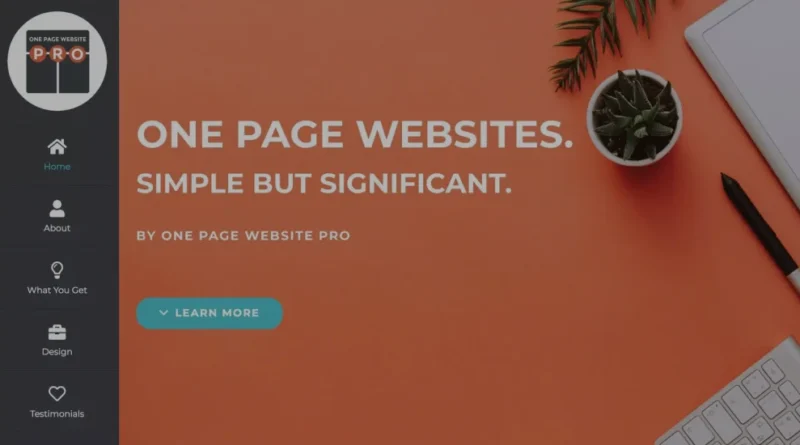Top 10 Single-Page Website Design Tips for Better User Experience
Websites nowadays need to provide users with easy access through speedy processes while creating smooth user experiences. The emergence of single-page web design serves as a choice that fulfills user needs. But what exactly is it? What measures should you apply to create an effective one-page web platform? Let’s dive in.
What is single-page web design?
All website content in single-page web design exists within a single web page under the name one-page website. The website presents all information on one page while users browse different sections through continuous scrolling. Each menu selection leads users directly to their needed section; thus, they remain on the same page.
The design fits businesses and startups as well as portfolios and events because it enables quick and stylish presentation of information without overwhelming visitors. The proper execution of a single-page website presents an entire narrative employing a single continuous sequence.
The following single-page web design tips will help you develop a page that maintains both attractiveness and functionality.
1. Define a Clear Purpose
Determine the main objective of your website before beginning design work. Do you seek to advertise your product along with your portfolios or build leads for your business? Clarity functions as the principal requirement because you have a single page from which to transmit your information. Each element through all website areas must guide users towards the main objective while avoiding interruptions.
2. Plan Your Content Hierarchy
A single-page website comprises a system that guides viewers through a series of organised presentations. Consider how your site visitors should follow the information. A proper layout normally progresses as follows:
- A strong hero section (headline and call to action)
- About or introduction
- Features or services
- Testimonials or social proof
- Call to action and contact information
The content flow should guide viewers between sections by creating smooth transitions that keep users content as they browse downward.
3. Use Strong Visual Anchors
Visual anchors play an essential role because the website lacks multi-page navigation. You should apply bold text elements combined with colour contrast and section separators and background variations to indicate transitional sections. Essential features are smooth scrolling animations because they naturally guide users through content while avoiding confusion and disorientation.
4. Keep It Simple and Focused
The essential principle for outstanding single-page web design consists of simplicity. One page should not contain too many pieces of information. The combination of short paragraphs with bullet points along with clear headings enables quick content skimming. Your message becomes easier to follow when it includes direct and to-the-point concepts, which prevents users from disengaging.
5. Optimise for Mobile Devices
Your site should be designed to adapt for smartphones since most viewers access websites through mobile devices. Verify that tiny screens present all components well while tap buttons and selectable text remain clear and responsive. Small images and videos should be your priority since they help maintain quick page speeds on mobile devices.
6. Highlight a Strong Call to Action (CTA)
Your call to action stands as the essential factor in a single-page site. The CTAs “Buy Now” and “Get a Quote,” together with “Contact Me,” require visual prominence along with multiple placements throughout the page. Place your call-to-action button in all primary locations of the webpage, which are the hero section and the middle and end of the web content.
7. Incorporate Interactive Elements
Your page will engage users through interactive elements that incorporate sliders for images and collapsible FAQs and statistics with animated appearances. The excessive use of moving content will obscure your core message, so apply such elements carefully.
8. Focus on Speed and Performance
A single-page website delivers all of its content immediately at the beginning of the load process. A page containing many images, videos, or animated content will reduce its performance speed. All media files should be optimised along with the implementation of lazy loading features to save performance while minimising the use of weighty plugins, which will ensure a smooth end-user experience.
9. Leverage SEO Best Practices
You can achieve effective optimisation despite the challenges that single-page sites present for search engine optimisation. The page needs structured HTML syntax combined with naturally integrated keywords, which should also have optimised meta titles that match the optimised descriptions. The implementation of anchor links, which function as page section jumpers, becomes a recommended internal linking technique.
10. Test, Analyse, and Iterate
The live release of your single-page website will enable you to observe user interactions with the system. The interaction habits of users are visible through Google Analytics and Hotjar in terms of scrolling behaviour, click rates, and abandonment points. Your updated design enhancements and content changes should be based on this data to produce superior results in the future.
Following these guidelines enables you to develop website experiences that engage visitors perfectly while omitting the need to navigate further than your main page.
Disclaimer
The information presented in this blog is derived from publicly available sources for general use, including any cited references. While we strive to mention credible sources whenever possible, Web Design Company in Mumbai does not guarantee the accuracy of the information provided in any way. This article is intended solely for general informational purposes. It should be understood that it does not constitute legal advice and does not aim to serve as such. If any individual(s) make decisions based on the information in this article without verifying the facts, we explicitly reject any liability that may arise as a result. We recommend that readers seek separate guidance regarding any specific information provided here.

